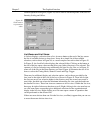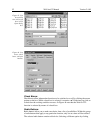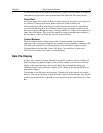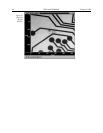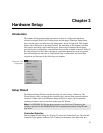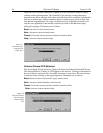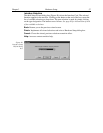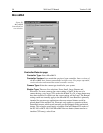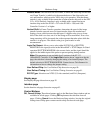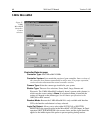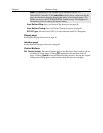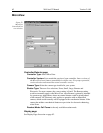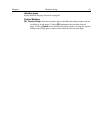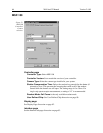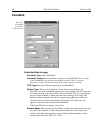
Chapter 3 Hardware Setup 59
Readout Mode:
The selections are Full Frame, in which the entire chip can be read
out, Frame Transfer, in which only the unmasked area of the chip can be read
out, and Interline, which provides 100% duty cycle operation. Note that frame
transfer is only available if the camera has a frame-transfer chip such as the EEV
512 × 1024. Similarly, Interline is only available with a camera having an
interline chip such as the PI 582 × 782 or the PI 1030 × 1300, and if the
Controller Version is 3 or higher.
Vertical Shift:
In Frame-Transfer operation, determines the speed of the image
transfer from the exposed area of a frame-transfer chip to the masked area.
Setting a lower value increases the shift speed. A higher value gives a slower
shift. If the shift is too fast, not all of the charge will be transferred. If too slow,
image smearing will be increased due to the exposure that takes place while the
transfer is in progress. The default value gives good results in most
measurements.
Logic Out Output:
Allows you to select either NOT SCAN or SHUTTER
MONITOR as the signal provided at the MicroMAX’s SCAN Output. In Gated
operation SHUTTER MONITOR is the correct choice and the signal should be
applied to the inhibit input of the pulser to prevent pulsing during readout.
Note:
This parameter is not available for all versions of the ST-133
(MicroMAX) Controller. If the
Logic Out
selection doesn’t appear on the tab
page, the selection is done by changing the setting of an internal jumper. The
default selection is SHUTTER MONITOR. Contact factory Tech Support for
information on how to change the jumper setting.
User Defined Chip:
See User Defined Chip discussion on page 80.
User Defined Timing:
See User Defined Timing discussion on page 81.
RS170 Type:
Selections are NTSC (US video standard) and PAL (European).
Display page
See Display tab page discussion on page 82.
Interface page
See the Interface tab page discussion on page 83.
Control Buttons:
OK, Cancel & Help:
These three buttons apply to the Hardware Setup window and are
available for all tab pages. Clicking
OK
implements the selections from all
pages. Clicking
Cancel
closes the Hardware Setup window, leaving the original
settings intact. Help opens context-sensitive help for the active tab page.



